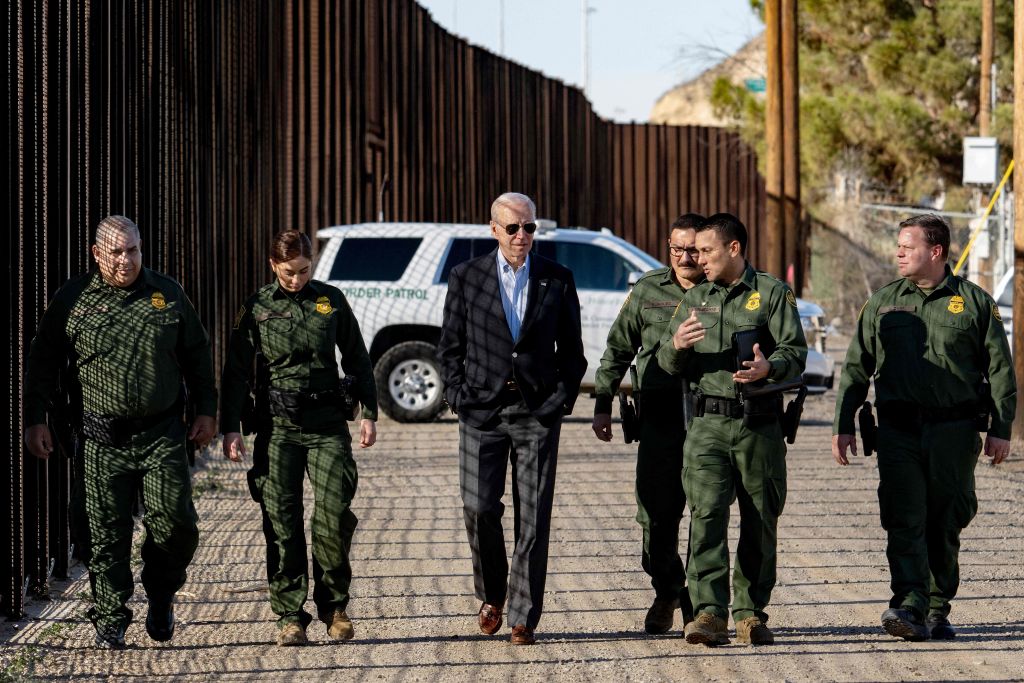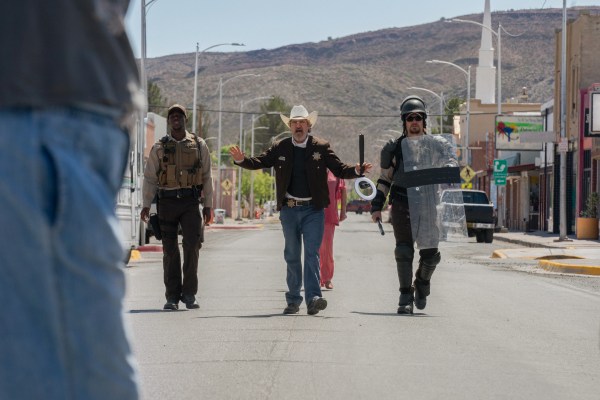Halfway into his term and just ahead of announcing his re-election bid, President Joe Biden took his medicine Sunday and visited the U.S.-Mexico border for the first time in his presidency.
For two years, Republicans have been goading Biden to visit the border. But he wouldn’t have had much to say before now. His administration has relied on a Trump-era pandemic policy that allowed the government to quickly expel asylum seekers, mostly from Central America and South America. It has been a useful tool, practically and politically. Under the auspices of nearly unlimited executive public health authority, Biden was able to battle an ongoing migrant crisis that has little to do with the coronavirus while blaming the pandemic for continuing the policies of a predecessor hated by Democrats.
But Biden, under heavy pressure from the activist left, is now trying to end the use of Title 42 of the Public Health Service Act of 1944 to expel migrants. The Supreme Court is making the president wait a bit at the request of states who sued to keep the rule in place. But it will fall soon, and Biden hopes a new policy announced last week to eject Cubans, Haitians, Nicaraguans, and Venezuelans who cross the border from Mexico illegally will be enough to soften the blow.
Biden finally has a policy of his own, so he had something to say when he went to El Paso. It’s just that a lot of folks on his team didn’t want to hear it.
The response from migrant advocates has been sharp. The policies “will unleash more suffering,” and cause “disparate harm to Black, Brown, & Indigenous asylum seekers,” according to the National Immigrant Justice Center’s Heidi Altman. Human Rights First, a group that includes some Obama administration alums, like former spokesman Jay Carney, called the rule “a humanitarian disgrace” that will be a “stain on the record of President Biden and his administration.”
After years of shooting rhetorical layups against the Trump administration over its immigration policies and border clampdown, Democrats find, to the surprise of no fair-minded person who has paid any attention, that the issues are brutally complicated and have a punishingly long time frame.
Officials made 2.4 million stops of migrants entering the U.S. illegally in the previous federal fiscal year. That’s a number larger than the populations of 15 states and the District of Columbia, and those are only the ones who got caught. Biden is certainly well-acquainted with the politics, since these are essentially the same issues the Obama administration tried and failed to resolve starting more than a dozen years ago. Then-President Obama’s 2011 visit to El Paso ahead of his own re-election bid had all the key problems that Obama’s former vice president faced this week.
Speaking to aid workers at the El Paso County Migrant Services Center on Sunday, Biden asked, “If I could wave the wand, what should I do?” Oof.
No doubt Biden could use a little magic. Running for re-election with continual crisis at the southern border is no good, but any solutions that might make a difference in enough time to be politically useful in a general election would do serious damage to Biden’s already shaky support from the hard left. If continuing to admit 30,000 asylum seekers from Cuba, Haiti, Nicaragua, and Venezuela is a “humanitarian disgrace,” the president doesn’t exactly have a lot of leeway with the activist community. And even if he hardens the border further, Republicans will still say Biden did too little, too late—and will no doubt still have the troubling images and data to support their claims.
That’s because the migration problem isn’t a Biden problem or a Trump problem, a Democratic one or a Republican one, but a global one that shows no signs of stopping. Rich, demographically stagnant nations in the northern hemisphere have found no reliable answers about what to do about the ongoing influx of migrants from the global south fleeing oppression, poverty, and violence in their native countries. It is one of the main challenges of this century and it is so far mostly unmet.
Authoritarian fantasies about hardened frontiers ignore the need for immigrant workers, while humanitarian pipe dreams about bounteous grants of asylum forget the needs of existing citizens and the duties of governments for national security. Not only are there no easy answers, even the simple answers are politically untenable, and there’s little reason to believe that will be any different in another dozen years.
Two years after Harry Truman won his stunning upset for a full term as president, his party got its teeth kicked in during the 1950 midterm elections.
American setbacks in Korea that year had sapped Truman’s political strength at home. The conflict was proving to be quite an embarrassment for a nation that had demanded a deep, rapid demobilization from World War II but found itself unable to deal swiftly with what had first looked to be a very puny North Korea.
Truman’s decision to commit U.S. ground forces after Kim il-Sung sent North Korean forces (and Soviet tanks) surging south was balanced on the edge of a knife. Truman and his advisers couldn’t let a Stalinist warmonger capture a U.S. ally’s capital without a reprisal, especially given the rising anxieties in the U.S. about communism. But as scary as the Reds were to American voters, neither was there any real interest in kicking off another massive global conflict with the hard-won peace from World War II so new.
Eighteen years later, Lyndon Johnson was essentially forced from office by the same hard politics that cost Truman’s Democrats in 1950 and handed the GOP the keys to the White House two years later. The struggle with the ambitions of Soviet communism was the dominant force in international history for the second half of the 20th century. That would have been true regardless of which party was in power, because as hard as it is for politicians to believe, world events are not entirely dictated by American political cycles.
In the first half of the 21st century, the struggle between the poor south and the wealthy north is a defining conflict. Success for our country and for its politicians will depend on accepting that fact and not pretending that a change in administrations can alter reality.







Please note that we at The Dispatch hold ourselves, our work, and our commenters to a higher standard than other places on the internet. We welcome comments that foster genuine debate or discussion—including comments critical of us or our work—but responses that include ad hominem attacks on fellow Dispatch members or are intended to stoke fear and anger may be moderated.
With your membership, you only have the ability to comment on The Morning Dispatch articles. Consider upgrading to join the conversation everywhere.